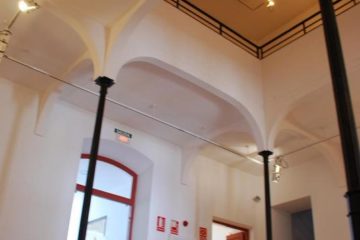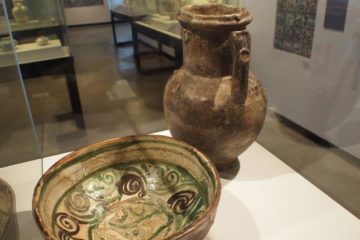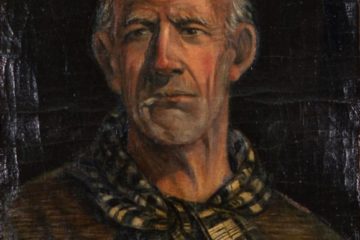The Motilla del Azuer is the most representative site of the Bronze Age in La Mancha (2200-1300 BC), within a unique type of settlement in prehistoric times, the motillas. These are so called because they form an artificial elevation within an eminently flat surrounding area. They are also considered exceptional monuments due to their scientific richness and their scarcity in number.
It is located on the fertile plain of the river of the same name, controlling and exploiting a territory that allowed access to basic productive resources, such as potentially optimal land from an agricultural and livestock point of view, water supply from the phreatic level, or control of natural routes, vital for exchanges between prehistoric groups.
The landscape was made up of holm oaks, gall oaks, oaks and cork oaks and shrubs such as junipers, mastic trees, strawberry trees and rockroses, alternating with crop fields and open spaces. Among the fauna present there is an abundance of deer, wild boar, hares and rabbits. The presence of carnivores such as the lynx, wild cat, badger, fox and birds such as the great bustard and partridge, together with various ducks and birds of prey, has also been documented.
The archaeological work carried out at the site has made it possible to delimit two distinct areas. The first of these corresponds to an interior fortified enclosure, made up of a series of concentric walls around a central quadrangular tower, which protected a set of structures where the economic activities of the site were managed and controlled. Among these elements are the large storage silos, with a capacity of around 6 m³, where products such as cereals, including different types of wheat and barley, or leguminous plants such as lentils, peas and peas, were stored, as well as ovens for firing pottery, roasting cereals and metallurgical production. The presence of livestock is also documented, consisting mainly of ovicaprids, followed in importance by bovids, horses, pigs and dogs.
Particularly significant is the large trapezoidal courtyard located to the east of the fortification, inside which there is a well for obtaining water. It is the oldest hydraulic structure documented on the Iberian Peninsula. It met the needs of the population by perforating the terraces of the river until it reached the water table.
The outermost line of fortification, which is circular and concentric to the defensive systems, has a wall of large limestone blocks in its last phase of construction. Access to the interior of the fortified area from the settlement was via corridors running parallel to the walls.
The dwellings were located outside the fortified core, in a diameter of about 50 metres, in which different huts, hearths and waste pits have been documented. These houses have an oval or rectangular floor plan, with a masonry plinth and mud elevation and, occasionally, posts embedded in the walls. Associated with this space are large open areas dedicated to different storage activities and production work, with the presence of pits and the remains of hearths and ovens. The analyses carried out in different investigations have allowed us to establish an occupation made up of a group of slightly more than one hundred individuals.
The distribution of the burials coincides with the area of the settlement, in a ritual common to most Bronze Age cultures on the Peninsula. The deceased were buried in a flexed lateral position, in simple pits, or lined with masonry walls or driven flagstones, which were sometimes attached to the walls of the dwellings or to the outer walls of the fortifications. Some children were deposited inside vessels. The grave goods are scarce and unrepresentative, consisting of ceramic vessels, rivet daggers and arsenical copper awls.
The monumental aspect of their architecture infers the great investment of effort involved in the construction and maintenance of all these structures, which exceeded the basic vital needs of these communities. This, together with other particularities, such as the regularity of their settlement patterns, leads us to consider the existence of a political system with a social hierarchy to be defined, within a territorial articulation in which the motillas would represent a singular landmark.
Tariffs and timetables
VISIT FOR INDIVIDUALS
General admission: 7,00 €.
The entrance fee to the Motilla del Azuer includes admission to the Regional Museum (Bronze Age room), as well as the transport service to and from the site itself.
* In order to visit the Motilla del Azuer you must purchase a ticket through this website or at the Damiel Regional Museum. Only the purchase of the ticket guarantees the visit to the site.
* As the number of places offered for the tour is limited to the number of places on the bus/all terrain vehicle, ALL visitors must purchase a ticket, including children of all ages.
VISIT FOR GROUPS
General admission
Groups up to 27 persons - 1 guide - € 60,00
Groups from 28 to 60 persons - 2 guides - 120,00 €.
Reduced entry
a) Students: Primary, Secondary and Baccalaureate
b) Pensioners (over 65 years old)
Groups up to 27 persons - 1 guide - € 55,00
Groups from 28 to 60 persons - 2 guides - 110,00 €.
Reservations must be made at least 48 hours in advance.
* 10% discount for travel agencies
* The price includes the entrance and guided visit to the Motilla del Azuer and the Bronze Age room of the Daimiel Regional Museum.
* The transfer to the archaeological site will be at the group's expense.
* In order to visit the Motilla del Azuer you must arrange a guided tour from the Regional Museum. Visits to the archaeological site are only possible with prior booking.
TIMETABLE
Visits for individuals
Saturdays (for Sundays check availability in the calendar)
Shift 1: - 09:30 h
Shift 2 : - 11:00 h
Shift 3 – 18:30 (June, July, August and until 15 September).
- 17:00 (April, May, from 16 September and October).
- 16:00 (November to March).
Start of the visit at the Daimiel Regional Museum.
Approximate duration of the entire visit: 2 hours and 30 minutes (approx.).
Maximum number of visitors per group: 18 people.
Group visits
Tuesday to Friday (morning and afternoon)
Saturdays (check availability on the calendar)
Sundays (mornings only)
Shift 1 - Morning hours - 10:00 a.m.
The start of the visit begins at Motilla del Azuer.
The group picks up the guide in the car park of the Daimiel Trade Fair Pavilion.
Duration of the visit: 3 hours and 20 minutes.
It is considered from the moment the bus arrives at the car park of the Daimiel Trade Fair Pavilion until the end of the visit at the Regional Museum.
Shift 2 - Afternoon hours - 16:00 hours (in July and August visits will start at 17:00 hours).
The visit begins at the Daimiel Regional Museum.
The bus must park at the bus station.
Duration of the visit: 2 hours 50 minutes
It is considered from the beginning of the visit at the Regional Museum until the end of the guided tour at the site itself.
PLEASE BE PUNCTUAL. Please note that late arrival will affect the progress of other groups' visits.
Other services of interest...

About us →


NATIONAL PARK OF LAS TABLAS DE DAIMIEL
Beneficiary: Tablas de Daimiel Tourist Association
Actions: Informative web page about the values of the National Park and the tourist services of Daimiel.
Action financed under the Programme of Subsidies in the areas of socio-economic influence of National Parks.
Además, compartimos información sobre el uso que haga del sitio web con nuestros partners de redes sociales, publicidad y análisis web, quienes pueden combinarla con otra información que les haya proporcionado o que hayan recopilado a partir del uso que haya hecho de sus servicios.
Usted acepta nuestras cookies si continúa utilizando nuestro sitio web.
Privacy policy
La ley afirma que podemos almacenar cookies en su dispositivo si son estrictamente necesarias para el funcionamiento de esta página. Para todos los demás tipos de cookies necesitamos su permiso.
Esta página utiliza tipos diferentes de cookies. Algunas cookies son colocadas por servicios de terceros que aparecen en nuestras páginas.
En cualquier momento puede cambiar o retirar su consentimiento desde la Declaración de cookies en nuestro sitio web.
Obtenga más información sobre quiénes somos, cómo puede contactarnos y cómo procesamos los datos personales en nuestra Privacy policy.
Su consentimiento se aplica a los siguientes dominios: https://daimielturismo.com
| Nombre | Proveedor | Propósito | Caducidad | Tipo |
|---|---|---|---|---|
| PHPSESSID | https://daimielturismo.com/ | Esta cookies es esencial para el funcionamiento de la web. | Sesión | HTTP |
| wordpress_logged_in | https://daimielturismo.com/ | Cookie de sesión de usuario al identificarse | Sesión | HTTP |
| wordpress_sec_ | https://daimielturismo.com/ | Cookie técnica de inicio de sesión | Sesión | HTTP |
| wordpress_test_cookie | https://daimielturismo.com/ | Comprueba si están activadas las cookies | Sesión | HTTP |
| wp-settings-time-1, wp-settings-1 | https://daimielturismo.com/ | Personalizar la interfaz de usuario. | 1 año | HTTP |
| cookies | https://daimielturismo.com/ | Almacena el estado de consentimiento de cookies del usuario para el dominio actual. | 1 año | HTTP |
| cookies-preferencias | https://daimielturismo.com/ | Almacena el estado de consentimiento de cookies de preferencias | 1 año | HTTP |
| cookies-estadisticas | https://daimielturismo.com/ | Almacena el estado de consentimiento de cookies de estadísticas | 1 año | HTTP |
| cookies-marketing | https://daimielturismo.com/ | Almacena el estado de consentimiento de cookies de marketing | 1 año | HTTP |
| cookies-no-clasificadas | https://daimielturismo.com/ | Almacena el estado de consentimiento de cookies no clasificadas | 1 año | HTTP |
| Nombre | Proveedor | Propósito | Caducidad | Tipo |
|---|---|---|---|---|
| _ga | google-analytics.com | Registra una identificación única que se utiliza para generar datos estadísticos acerca de cómo utiliza el visitante el sitio web. | 2 años | HTTP |
| _gid | google-analytics.com | Registra una identificación única que se utiliza para generar datos estadísticos acerca de cómo utiliza el visitante el sitio web. | 1 día | HTTP |
| _gat | google-analytics.com | Utilizado por Google Analytics para controlar la tasa de peticiones | 1 día | HTTP |




















